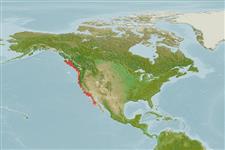Teleostei (teleosts) >
Perciformes/Scorpaenoidei (Scorpionfishes) >
Sebastidae (Rockfishes, rockcods and thornyheads) > Sebastinae
Etymology: Sebastes: Greek, sebastes = august, venerable (Ref. 45335); miniatus: From the Greek miniatus, meaning 'vermilion' (Ref. 27436).
More on authors: Jordan & Gilbert.
Environment: milieu / climate zone / depth range / distribution range
Ecology
Marine; reef-associated; depth range 15 - 467 m (Ref. 27437), usually 50 - 274 m (Ref. 27437). Subtropical; 8°C - 9°C (Ref. 131066); 62°N - 27°N, 149°W - 113°W
Eastern Pacific: Prince William Sound, Alaska and Queen Charlotte Island, British Columbia, Canada to central Baja California, Mexico.
Length at first maturity / Size / Weight / Age
Maturity: Lm 37.0, range 37 - 46 cm
Max length : 91.0 cm TL male/unsexed; (Ref. 27436); max. published weight: 6.8 kg (Ref. 2850); max. reported age: 60 years (Ref. 56049)
Dorsal spines (total): 13; Dorsal soft rays (total): 13 - 15; Anal spines: 3; Anal soft rays: 7. Head spines moderate to weak - nasal, preocular, supraocular, postocular, tympanic and parietal spines present, nuchals usually absent, coronals absent (Ref. 27437). Lower jaw rough and scaly; caudal peduncle deep (Ref. 27437). Caudal fin slightly indented (Ref. 6885). Dark red in color, sides mottled with gray; mouth and fins red, fins usually edged with black; 3 obscure stripes radiating from each eye (Ref. 27437).
Adults inhabit shallow to deep rocky reefs, less common on deep ones (Ref. 2850). Young inhabit shallow water (Ref. 2850). Viviparous (Ref. 34817). Sold as fillets together with other rockfish (Ref. 27436). Maximum depth and minimum common depth from Ref. 128668.
Eschmeyer, W.N., E.S. Herald and H. Hammann, 1983. A field guide to Pacific coast fishes of North America. Boston (MA, USA): Houghton Mifflin Company. xii+336 p. (Ref. 2850)
IUCN Red List Status (Ref. 130435: Version 2024-1)
Threat to humans
Harmless
Human uses
Fisheries: minor commercial; gamefish: yes; aquarium: public aquariums
Tools
Special reports
Download XML
Internet sources
Estimates based on models
Preferred temperature (Ref.
123201): 6.4 - 9.9, mean 6.9 °C (based on 16 cells).
Phylogenetic diversity index (Ref.
82804): PD
50 = 0.5000 [Uniqueness, from 0.5 = low to 2.0 = high].
Bayesian length-weight: a=0.01000 (0.00495 - 0.02022), b=3.09 (2.92 - 3.26), in cm total length, based on LWR estimates for this Genus-body shape (Ref.
93245).
Trophic level (Ref.
69278): 3.9 ±0.5 se; based on size and trophs of closest relatives
Generation time: 7.9 ( na - na) years. Estimated as median ln(3)/K based on 2
growth studies.
Resilience (Ref.
120179): Low, minimum population doubling time 4.5 - 14 years (tm=6; tmax =60).
Fishing Vulnerability (Ref.
59153): Moderate to high vulnerability (51 of 100).
Nutrients (Ref.
124155): Calcium = 11.3 [4.2, 35.4] mg/100g; Iron = 0.336 [0.131, 0.813] mg/100g; Protein = 19.3 [18.2, 20.6] %; Omega3 = 0.393 [0.155, 1.005] g/100g; Selenium = 58 [20, 180] μg/100g; VitaminA = 55.3 [19.4, 153.8] μg/100g; Zinc = 0.425 [0.215, 0.826] mg/100g (wet weight);
